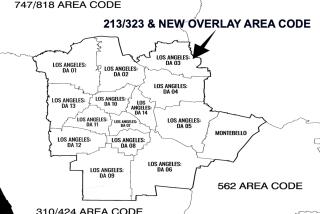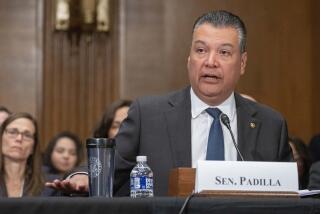The 411 on 011, 111, 211 . . .
Few phone numbers are more recognizable in the United States than 411 for directory assistance and 911 for summoning emergency help. But in the coming years, those so-called special services codes will have some company.
The Federal Communications Commission adopted rules in 1992 that require phone companies to provide abbreviated dialing arrangements that make it easier for consumers to access important services. Most three-digit prefixes get gobbled up for use as area codes and local phone numbers. But with 911 and 411 already in widespread use, the FCC designated the remaining “N11”’ numbers for special public uses.
As three-digit dialing codes become more widely used, it’s important for callers to know more about them.
* 011 and 111: Not available for use as special codes (or for area codes) because they begin with 0 or 1, digits used by telephone equipment for switching and routing calls. People who make international calls, for example, first dial 011 to initiate an overseas call before dialing the appropriate country code and phone number.
* 211: Assigned nationally in July for community and referral services. Several areas, including Atlanta and the state of Connecticut, already use the abbreviated 211 code for the same purpose. Advocates say the introduction of the 211 code in those locations reduced consumer confusion and led to a sharp increase in calls for community assistance and other programs. In Atlanta and Connecticut, the 211 information and referral services are funded through donations to United Way and government grants.
The 211 providers vary by state, but they generally will be set up as a single point of contact for people who want information or assistance through a wide range of health and human services programs. Employees at regional 211 calling centers will handle questions, make referrals and guide people through the maze of groups that specialize in housing assistance, food programs, counseling, hospice, substance abuse, domestic violence and other aid.
The 211 code is not yet working in California, but several established organizations, including Info Line of Los Angeles, are working with regulators and the state’s two largest local phone companies, Pacific Bell and Verizon Communications (formerly GTE), to allow existing referral programs to switch to the new 211 number.
* 311: Assigned nationwide for nonemergency police and other governmental services. Its primary purpose is to establish a widely recognized code for use for nonemergency situations, such as reporting non-injury car accidents. It has been promoted as a way to keep 911 lines open for true emergencies.
Although 311 is already in use by public agencies in some parts of the country, it is not yet established in California. A test run by Verizon in the Bay Area was considered a success, but a bill that would launch the service throughout the state was vetoed by Gov. Gray Davis.
* 411: Used almost universally by phone companies for directory assistance.
* 511: Assigned in July for national use to give callers detailed traffic and transportation information. The federal Department of Transportation lobbied for this designation, arguing that state and local agencies could use the 511 code to help disseminate key details about road work and closures, accidents, traffic jams, commuter rail services and other travel-related information.
The transportation agency said the current system is a patchwork of travel information services run by at least 43 states, 42 major cities and more than 100 transit agencies--with most of them phone-based systems. Someone driving from New York to Washington, D.C., for example, would have to dial 11 different phone numbers to get relevant traffic and transit status reports, the agency said.
Adding the code allows users to dial it without worrying about crossing area code lines or memorizing different phone numbers for different regions. The new 511 services are not yet in place, and it is unclear how the program will be set up and funded in California. A pilot project is in the planning stages for the Bay Area.
* 611: No official designation, but many phone companies have set aside this number for customers to call for repair or service requests. In California, PacBell and Verizon use 611 for repair calls.
* 711: Assigned nationwide for access to telecommunications relay services and other assistance for callers who are hard of hearing. Typically, relay services use an operator and a special teletypewriter (or TTY) to help people with hearing or speech impairments have conversations over the phone. The operator receives written conversation through the TTY machine and reads it aloud to the non-TTY user on the other end of the line, then relays the spoken response by typing it for display on the TTY, and so on.
Some states have already adopted the 711 shortcut as the dial-in number for their relay services. Many others, including California, provide the service through special toll-free phone numbers and have not yet activated 711.
* 811: No official designation, but some phone companies use it to give business customers quick access to service and billing assistance. Pacific Bell uses the code for repair calls from priority customers. Verizon does not use the code in California.
* 911: Set aside nationwide for emergency calls for police, fire and medical help. Paid for by consumers through a fee on telephone bills.
*
Times staff writer Elizabeth Douglass covers telecommunications.
More to Read
Sign up for Essential California
The most important California stories and recommendations in your inbox every morning.
You may occasionally receive promotional content from the Los Angeles Times.










